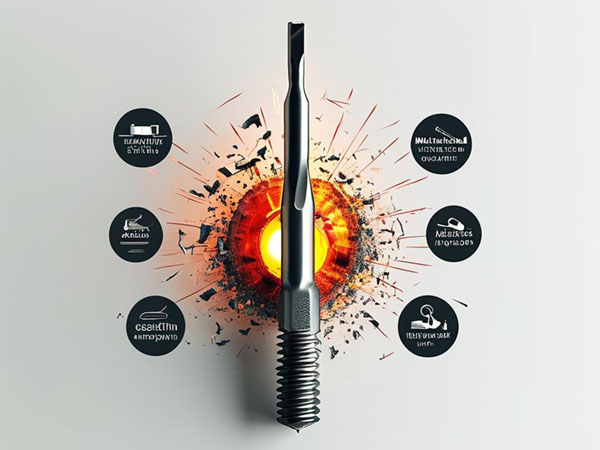
Thread taps are essential tools used for internal thread cutting in mechanical processing and precision manufacturing. However, during extended use under high loads, taps can experience various types of failure, leading to reduced machining accuracy, decreased production efficiency, and even product quality issues. By analyzing the causes of tap failure, we can effectively optimize tap design and usage to extend tool life and enhance production efficiency. This article will analyze common tap failure modes and propose corresponding solutions and optimization measures.
1. Wear
Failure Manifestation
Wear is the most common failure mode of thread taps, typically manifesting as blunt cutting edges, rough thread surfaces, increased cutting forces, and decreased thread accuracy. Over time, wear significantly reduces the tap's machining capacity, affecting production efficiency and quality.
- Cutting edge blunting (edge radius > 0.05 mm)
- Uniform wear band (0.2–0.5 mm) on flank face
- Thread pitch diameter deviation (> 0.02 mm)
Causes
Excessive Cutting Heat: Prolonged high temperatures can reduce the hardness of the tap edges, making them more prone to wear.
Improper Cutting Parameters: High cutting speeds and feed rates increase friction, accelerating tool wear.
Material Properties: When cutting hard or difficult-to-machine materials, the tap's cutting edges are more susceptible to wear.
Solutions
Use taps made from more wear-resistant materials, such as high-speed steel, carbide, or coated taps.
Adjust cutting parameters by reducing cutting speed and feed rate to control temperature and friction.
Use appropriate cooling fluids to lower cutting temperatures and reduce wear.
Optimization Measures
Select High Wear-Resistant Materials: Use materials such as TiN-coated high-speed steel or carbide to enhance wear resistance.
Optimize Coating Technology: Employ multi-layer coating technologies (e.g., TiAlN, TiCN coatings) to significantly improve wear resistance and heat resistance.
Regular Inspection and Replacement: Regularly check the tap's cutting edges for wear and replace excessively worn taps promptly.
2. Fracture
Failure Manifestation
Fracture typically occurs during the machining process, especially in deep-hole tapping or under excessive load. Fractures can interrupt production and damage workpieces. The fracture usually occurs at the weakest points of the tap, such as the cutting edges or thread portions.
- 45° oblique cracks at spiral flute roots
- Shank torsion deformation (> 3°)
- Cutting edge chipping (> 1/3 edge length)
Causes
Excessive Cutting Forces: High cutting depth or feed rates can lead to excessive cutting forces, increasing the risk of fracture.
Brittle Materials: Taps made from hard materials, such as carbide, are more prone to fracture when machining hard materials due to their brittleness.
Excessive Cutting Heat: High temperatures may reduce the tap's toughness, leading to fracture.
Solutions
Reduce cutting depth and feed rate to minimize cutting forces.
Use tougher tap materials, such as high-strength steel, for brittle material processing.
Ensure effective cooling to prevent excessive heat buildup.
Optimization Measures
Design Taps with Greater Toughness: Improve the tap's design by enhancing edge toughness and resistance to fracture, such as using gradual edge angles or adding reinforcement to critical areas.
Control Cutting Parameters: Precisely control cutting depth, feed rate, and cutting speed to prevent excessive cutting forces that could lead to fractures.
3. Built-up Edge (BUE)
Failure Manifestation
Built-up edge (BUE) occurs mainly when cutting soft metals such as aluminum or copper. The metal adheres to the tap's cutting edges, forming a sticky layer that hinders the cutting process. This results in rough thread surfaces, increased cutting forces, and potential tool clogging.
- Adhered chips (BUE height > 0.1 mm)
- Scaled thread surfaces (Ra > 3.2 μm)
- Abnormal cutting temperature (> 600°C)
Causes
High Adhesion of Soft Metals: Certain soft metals (e.g., aluminum, lead) tend to adhere to tool surfaces at high temperatures.
Inadequate Cooling: Insufficient or inefficient cooling fails to control cutting temperatures, promoting the formation of a built-up edge.
Inappropriate Tap Materials: Non-coated or poorly coated taps are more prone to material adhesion.
Solutions
Use coated taps (e.g., TiN-coated, black oxide-coated) to reduce adhesion of material to the cutting edge.
Increase the use of cooling fluids to control temperatures and prevent built-up edge formation.
Select taps made from materials suitable for machining soft metals, such as coated high-speed steel or carbide.
Optimization Measures
Enhance Coating Technology: Use coatings such as TiAlN, which have better resistance to built-up edge formation, to improve tool performance.
Improve Cooling Systems: Employ high-pressure coolant systems to deliver coolant directly to the cutting area, enhancing cooling efficiency.
4. Overheating
Failure Manifestation
Overheating can cause the tap's hardness to decrease, leading to increased wear, softening, or even fracture. Taps that overheat may exhibit discoloration (e.g., turning blue or purple) and suffer from reduced machining precision.
- Tempering colors (yellow → blue) on edges
- Coating spalling (> 30% area loss)
- Hardness reduction (ΔHV > 200)
Causes
Excessive Cutting Speed: High cutting speeds generate excessive heat, causing the tap to overheat.
Insufficient Cooling: Inadequate or ineffective cooling fluid reduces the ability to dissipate heat from the cutting area.
High Cutting Forces: Excessive cutting forces increase friction and heat generation, leading to overheating.
Solutions
Reduce cutting speed and feed rate to minimize heat generation.
Enhance cooling effectiveness by using appropriate coolant fluids.
Use an efficient coolant delivery system to ensure proper heat dissipation.
Optimization Measures
Enhance Cooling Efficiency: Implement high-pressure coolant systems to deliver coolant directly to the cutting area and reduce temperatures.
Use Heat-Resistant Materials: Use coatings such as TiN, TiAlN, or diamond-like carbon (DLC) coatings that can withstand higher cutting temperatures, reducing overheating risks.
5. Thread Flaking
Failure Manifestation
Thread Flaking occurs when small sections of the thread are removed, usually near the cutting edges or thread portions. This results in irregular thread profiles and poor surface finish.
- Localized crest spalling (depth > 0.05 mm)
- Flaky thread surfaces
- Pitch diameter fluctuation (> 0.02 mm)
Causes
Excessive Hardness of Material: When machining harder materials, the tap's threads may be subjected to excessive cutting forces, leading to chipping.
Improper Cutting Parameters: High cutting forces or speeds can cause excessive stress on the threads, resulting in chipping.
Inadequate Tap Material: Taps with insufficient tensile strength are more prone to thread chipping.
Solutions
Use taps made from high-strength materials, such as high-speed steel or carbide, for hard material machining.
Control cutting parameters, especially cutting forces, to prevent excessive stress on the threads.
Choose the appropriate tap for the material being processed, such as carbide taps for hard metals.
Optimization Measures
Strengthen Tap Design: Reinforce the tap’s thread portion and cutting edges to reduce the risk of chipping.
Control Cutting Forces: Optimize cutting depth, feed rate, and speed to maintain cutting forces within acceptable limits and prevent thread damage.
6. Vibration
Failure Manifestation
Vibration during tapping leads to cutting instability, resulting in uneven thread formation and potentially damaging the tap or workpiece. Vibration can cause taps to wear unevenly or fracture.
- Periodic surface waves (0.1–0.3 mm wavelength)
- Oval pitch diameter (> 0.01 mm deviation)
- Excessive noise (> 85 dB)
Causes
Improper Cutting Conditions: Excessive feed rates or cutting depths can induce vibration during machining.
Unstable Workpiece Clamping: Insecure workpiece clamping can cause the workpiece to vibrate during machining.
Insufficient Tap Rigidity: Low-rigidity taps are more susceptible to vibration, especially during deep hole tapping.
Solutions
Optimize cutting parameters by reducing feed rates and cutting depths to prevent vibration.
Ensure stable workpiece clamping using proper fixtures and tooling to reduce vibration.
Use taps with higher rigidity to minimize vibration effects.
Optimization Measures
Improve Workpiece Clamping: Use proper fixtures or tool holders that reduce vibration and ensure stable machining.
Use Rigid Taps: Design taps with higher rigidity to resist vibration and maintain cutting stability during operation.
7. Lack of Proper Chip Removal Design
Failure Manifestation
Poor chip removal design can lead to chip clogging in the cutting area, increasing cutting resistance and causing tool wear or damage. It can also result in incomplete thread formation.
- Flute blockage
- Chip entanglement causing scratches
- Torque fluctuation (> 20%)
Causes
Insufficient Chip Flute Design: Taps with poorly designed or insufficiently wide flutes may struggle to remove chips effectively, especially in deep-hole applications.
Excessive Cutting Depth: Deep holes can create long chips that are difficult to evacuate, leading to clogging.
Inadequate Cooling or Chip Removal System: Inefficient cooling or chip removal systems exacerbate chip buildup.
Solutions
Optimize flute design to ensure effective chip removal, especially in deep-hole tapping.
Control cutting depth to prevent excessive chip buildup, ensuring smooth chip evacuation.
Enhance the cooling and chip removal system to support efficient chip management.
Optimization Measures
Improve Flute Design: Design taps with wider or multiple chip flutes to ensure efficient chip evacuation.
Enhance Chip Removal Systems: Implement high-pressure coolant systems that aid in chip removal, particularly in deep-hole applications.
In summary
By thoroughly analyzing the causes of common tap failures, manufacturers can make informed decisions to optimize tap design and usage. Implementing strategies such as selecting high-quality materials and coatings, optimizing cutting parameters, enhancing cooling systems, and improving tool geometry can significantly reduce the occurrence of failures, extending tool life and improving overall machining performance. Regular monitoring, maintenance, and timely tool replacement further contribute to a stable and efficient machining process.
OEM Capability
 We like to do design according to all the customers' requirements, or offer them our new designs. With strong OEM/ODM capabilities, we can fill your sourcing demands.
We like to do design according to all the customers' requirements, or offer them our new designs. With strong OEM/ODM capabilities, we can fill your sourcing demands. Categories
| HSS-PM Taps | HSSE-M42 Taps |
| HSSE / HSS Taps | Spiral Flute Taps |
| Straight Flute Taps | Spiral Point Taps |
| Multi-function Taps |
| Solid Carbide Drill Bits | Twist Drill Bits |
| Center Drill Bits | Indexable U Drills |
| Flat-end Milling Cutter | Ball Nose End Mills |
